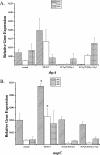In vivo mutations of thymidylate synthase (encoded by thyA) are responsible for thymidine dependency in clinical small-colony variants of Staphylococcus aureus
- PMID: 17905979
- PMCID: PMC2223566
- DOI: 10.1128/JB.00912-07
In vivo mutations of thymidylate synthase (encoded by thyA) are responsible for thymidine dependency in clinical small-colony variants of Staphylococcus aureus
Abstract
Trimethoprim-sulfamethoxazole (SXT)-resistant Staphylococcus aureus thymidine-dependent small-colony variants (TD-SCVs) are frequently isolated from the airways of cystic fibrosis (CF) patients, often in combination with isogenic normal strains if patients were treated with SXT for extended periods. As SXT inhibits the synthesis of tetrahydrofolic acid, which acts as a cofactor for thymidylate synthase (thyA), the survival of TD-SCVs depends exclusively on the availability of external thymidine. Since the underlying mechanism for thymidine dependency is unknown, we investigated if alterations in the thyA nucleotide sequences were responsible for this phenomenon. Sequence analysis of several clinical TD-SCVs and their isogenic normal strains with reference to previously published S. aureus thyA nucleotide sequences was performed. Three clinical TD-SCVs were complemented by transforming TD-SCVs with the vector pCX19 expressing ThyA from S. aureus 8325-4. Transcriptional analysis of metabolic and virulence genes and regulators (agr, hla, spa, citB, thyA, and nupC) was performed by quantitative reverse transcription-PCR. The previously published sequences of thyA and two normal clinical strains were highly conserved, while thyA of four normal strains and four SCVs had nonsynonymous point mutations. In 8/10 SCVs, deletions occurred, resulting in stop codons which were located in 4/10 SCVs close to or within the active site of the protein (dUMP binding). Complementation of TD-SCVs with thyA almost fully reversed the phenotype, growth characteristics, and transcription patterns. In conclusion, we demonstrated that mutations of the thyA gene were responsible for the phenotype of TD-SCVs. Complementation of TD-SCVs with thyA revealed that a functional ThyA protein is necessary and sufficient to change the SCV phenotype and behavior back to normal.
Figures




References
-
- Besier, S., A. Ludwig, K. Ohlsen, V. Brade, and T. A. Wichelhaus. 2007. 2007. Molecular analysis of the thymidine-auxotrophic small colony variant phenotype of Staphylococcus aureus. Int. J. Med. Microbiol. 297217-225. - PubMed
-
- Carreras, C. W., and D. V. Santi. 1995. The catalytic mechanism and structure of thymidylate synthase. Annu. Rev. Biochem. 64721-762. - PubMed
Publication types
MeSH terms
Substances
LinkOut - more resources
Full Text Sources
Medical
Research Materials

